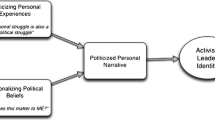Abstract
This study draws on theories of personalist culture and social performance to explain why organizations in the field of faith-based community organizing are able to effectively engage people in collective action on multiple issues across social difference. Using two qualitative datasets, we document the construction and transformation of personal motivations in interactive social movement settings, and show the importance of this process for mobilizing action in pursuit of a multi-issue social justice agenda. Through cultural practices that construct moral meaning in interactive settings, activists learn to internalize a collective moral imaginary – a cultural schema that affirms the importance of individuals’ personal motivations, links these to those of other people, and situates them within a larger social structure. This expands individuals’ understandings of self and community, and thus frames multi-issue social justice activism organized across social difference as a morally compelling and effective means of pursuing personal interests and motivations.
Similar content being viewed by others
Notes
ELIJAH is a pseudonym, but not an acronym. The names of all persons in this study have been changed to protect participants’ confidentiality.
Although all of ELIJAH’s affiliate churches are rooted in Christian faith traditions, significant bridging work is required to develop unity within the organization. For discussions of bridging among Christian communities in the FBCO field, see Braunstein et al (2014), Swarts (2011), and Warren (2001).
References
Alexander, J.C. (2004) “Cultural pragmatics: Social performance between ritual and strategy.” Sociological Theory 22(4):527–73.
Alexander, J.C. and Smith, P. (1993) “The discourse of American civil society: A new proposal for cultural studies.” Theory and Society 22(2):151–207.
Becker, P.E. (1999) Congregations in Conflict: Cultural Models of Local Religious Life. New York: Cambridge University Press.
Bellah, R.N., Madsen, R., Sullivan, W.M., Swidler, A. and Tipton, S.M. (1985) Habits of the Heart: Individualism and Commitment in American Life. Berkeley: University of California Press.
Benford, R.D. and Snow, D.A. (2000) “Framing processes and social movements: An overview and assessment.” Annual Review of Sociology 26:611–39.
Beyerlein, K. and Vaisey, S. (2013) “Individualism revisited: Moral worldviews and civic engagement.” Poetics 41(4):384–406.
Bothwell, R.O. (2003) “The decline of progressive policy and the New Philanthropy”, (https://comm-org.wisc.edu/papers2003/bothwell/). accessed 6 July 2016.
Bourdieu, P. (1984) Distinction: A Social Critique of the Judgement of Taste. Cambridge, MA: Harvard University Press.
Braunstein, R. (2012) “Storytelling in liberal religious advocacy”. Journal for the Scientific Study of Religion 51(1):110–27.
Braunstein, R. (2015) “The tea party goes to Washington: Mass demonstrations as performative and interactional processes”. Qualitative Sociology 38(4):353–74.
Braunstein, R., Fulton, B.R. and Wood, R.L. (2014) “The role of bridging cultural practices in racially and socioeconomically diverse civic organizations.” American Sociological Review 79(4):705–25.
Brueggeman, W. (2001) The Prophetic Imagination. Minneapolis, MN: Fortress Press.
Delehanty, J.D. (2016) “Prophets of resistance: Social justice activists contesting comfortable church culture.” Sociology of Religion 77(1):37–58.
Duggan, L. (2004) The Twilight of Equality? Neoliberalism, Cultural Politics, and the Attack on Democracy. Boston: Beacon Press.
Dunn, J.L. (2004) “The politics of empathy: Social movements and victim repertoires.” Sociological Focus 37(3):235–50.
Edgell, P. (2012) “A cultural sociology of religion: New directions”. Annual Review of Sociology 38(1):247–65.
Eliasoph, N. (2011) Making Volunteers: Civic Life after Welfare’s End. Princeton, NJ: Princeton University Press.
Enriquez, L.E. and Saguy, A.C. (2016) “Coming out of the shadows: Harnessing a cultural schema to advance the undocumented immigrant youth movement.” American Journal of Cultural Sociology 4(1):107–30.
Ewick, P. and Silbey, S. (2003) “Narrating social structure: Stories of resistance to legal authority.” American Journal of Sociology 108:1328–72.
Gamson, W.A. (1992) Talking Politics. New York: Cambridge University Press.
Ganz, M. (2000) “Resources and resourcefulness: Strategic capacity in the unionization of California agriculture, 1959–1966.” American Journal of Sociology 105(4):1003–62.
Gecan, M. (2004) Going Public: An Organizer’s Guide to Citizen Action. New York: Anchor.
Giddens, A. (1991) Modernity and Self-Identity: Self and Society in the Late Modern Age. Palo Alto: Stanford University Press.
Goffman, E. (1974) Frame Analysis: An Essay on the Organization of Experience. London: Harper and Row.
Han, H. (2014) How Organizations Develop Activists: Civic Associations and Leadership in the 21st Century. New York: Oxford University Press.
Hart, S. (2001) Cultural Dilemmas of Progressive Politics: Styles of Engagement Among Grassroots Activists. Chicago: University of Chicago Press.
Jasper, J.M. (2012) “Choice Points, Emotional Batteries, and Other Ways to Find Strategic Action at the Microlevel.” pp. 23–42 in Strategies for Social Change, edited by G.M. Maney, R.V. Kutz-Flamenbaum, D.A. Rohlinger, and J. Goodwin. Minneapolis: University of Minnesota Press.
Johnston, E.F. (2013) “‘I was always this way…’: Rhetorics of continuity in narratives of conversion.” Sociological Forum 28(3):549–73.
Kleidman, R. (2004) “Community organizing and regionalism.” City & Community 3(4):403–21.
Kolb, K.H. (2014) “Emotional subcultures.” Sociology Compass 8(11):1229–41.
Lamont, M. and Molnár, V. (2002) “The study of boundaries in the social sciences.” Annual Review of Sociology 28:167–95.
Lareau, A. (2003) Unequal Childhoods. Berkeley: University of California Press.
Leondar-Wright, B. (2014) Missing Class: Strengthening Social Movement Groups by Seeing Class Cultures. Ithaca, NY: Cornell University Press.
Lichterman, P. (1995) “Beyond the seesaw model: Public commitment in a Culture of self-fulfillment”. Sociological Theory 13(3):275–300.
Lichterman, P. (1996) The Search for Political Community: American Activists Reinventing Commitment. New York: Cambridge University Press.
Lichterman, P. (2005) Elusive Togetherness: Church Groups Trying to Bridge America’s Divisions. Princeton, NJ: Princeton University Press.
Lichterman, P. (2008) “Religion and the Construction of Civic Identity.” American Sociological Review 73(1):83–104.
Lichterman, P. and Eliasoph, N. (2015) “Civic action.” American Journal of Sociology 120(3):798–863.
Lizardo, O. and Strand, M. (2010) “Skills, toolkits, contexts and institutions: Clarifying the relationship between different approaches to cognition in cultural sociology.” Poetics 38(2):205–28.
Madsen, R. (2009) “The archipelago of faith: Religious individualism and faith community in america today.” American Journal of Sociology 114(5):1263–1301.
McAdam, D. (1999) Political Process and the Development of Black Insurgency, 1930–1970. Chicago: University of Chicago Press.
McAdam, D. and Kloos, K. (2014) Deeply Divided: Racial Politics and Social Movements in Postwar America. New York: Oxford University Press.
McAdam, D., Sampson, R., Weffer, S. and MacIndoe, H. (2005) “‘There will be fighting in the streets’: The distorting lens of social movement theory.”.” Mobilization: An International Quarterly 10(1):1–18.
Mills, C.W. (1959) The Sociological Imagination. New York: Oxford University Press.
O’Brien, J. (2015) “Individualism as a discursive strategy of action: Autonomy, agency, and reflexivity among religious Americans.” Sociological Theory 33(2):173–99.
Orfield, M. (1997) Metropolitics: A Regional Agenda for Community and Stability. Washington: Brookings Institution Press.
Oyakawa, M. (2015) “‘Turning private pain into public action’: The cultivation of identity narratives by a faith-based community organization.” Qualitative Sociology 38(4):395–415.
Perrin, A. (2014) American Democracy: From Tocqueville to Town Halls to Twitter. Boston: Polity.
Polletta, F. (2005) “How participatory democracy became white: Culture and organizational choice”. Mobilization: An International Quarterly 10(2):271–88.
Polletta, F. (2006) It Was Like a Fever: Storytelling in Protest and Politics. Chicago: Univerrsity of Chicago Press.
Putnam, R.D. (2000) Bowling Alone: The Collapse and Revival of American Community. New York: Simon & Schuster.
Roelofs, J. (2003) Foundations and Public Policy: The Mask of Pluralism. Albany: State University of New York Press.
Sampson, R.J., McAdam, D., MacIndoe, H. and Weffer-Elizondo, S. (2005) “Civil society reconsidered: The durable nature and community structure of collective civic action.” American Journal of Sociology 111(3):673–714.
Skocpol, T. (1995) Protecting Soldiers and Mothers: The Political Origins of Social Policy in United States. Cambridge, MA: Belknap Press of Harvard University Press.
Skocpol, T. (2003) Diminished Democracy: From Membership to Management in American Civic Life. Norman, OK: University of Oklahoma Press.
Smilde, D. (2007). Reason to Believe: Cultural Agency in Latin American Evangelicalism. Berkeley: University of California Press.
Smith, A. (2007) The Revolution Will Not Be Funded: Beyond the Non-Profit Industrial Complex. Boston: South End Press.
Smith, C. (1996) Disruptive Religion: The Force of Faith in Social-Movement Activism. New York: Routledge.
Smith, C. (2009). Souls in Transition: The Religious and Spiritual Lives of Emerging Adults. New York: Oxford University Press.
Snow, D.A., Rochford Jr, E.B., Worden, S.K. and Benford, R.D. (1986) “Frame alignment processes, micromobilization, and movement participation.” American Sociological Review 51(4):464–81.
Stout, J. (2012) Blessed Are the Organized: Grassroots Democracy in America. Princeton, NJ: Princeton University Press.
Swarts, H. (2011) “Drawing new symbolic boundaries over old social boundaries: forging social movement unity in congregation-based community organizing.” Sociological Perspectives 54(3):453–77.
Swarts, H.J. (2008) Organizing Urban America: Secular and Faith-Based Progressive Movements. Minneapolis: University of Minnesota Press.
Vaisey, S. (2009) “Motivation and justification: A dual-process model of culture in action.” American Journal of Sociology 114(6):1675–1715.
Vaisey, S. and Lizardo, O. (2016) “Cultural fragmentation or acquired dispositions? A new approach to accounting for patterns of cultural change.” Socius: Sociological Research for a Dynamic World 2:2378023116669726.
Ward, J. (2008) “White normativity: the cultural dimensions of whiteness in a racially diverse LGBT organization.” Sociological Perspectives 51(3):563–86.
Warren, M.R. (2001) Dry Bones Rattling: Community Building to Revitalize American Democracy. Princeton, NJ: Princeton University Press.
Williams, R.H. (1999) “Visions of the good society and the religious roots of american political culture.” Sociology of Religion 60(1):1–34.
Winchester, D. (2008) “Embodying the faith: Religious practice and the making of a Muslim moral habitus.” Social Forces 86(4):1753–80.
Wood, R.L. (1999) “Religious culture and political action.” Sociological Theory 17(3):307–32.
Wood, R.L. (2002) Faith in Action: Religion, Race, and Democratic Organizing in America. Chicago: University of Chicago Press.
Wood, R.L. and Fulton, B.R. (2015) A Shared Future: Faith-Based Organizing for Racial Equity and Ethical Democracy. Chicago: University of Chicago Press.
Wuthnow, R. (1991) Acts of Compassion. Princeton, NJ: Princeton University Press.
Zald, M.N. (1996) “Culture, Ideology, and Strategic Framing.” in Comparative Perspectives on Social Movements: Political Opportunities, Mobilizing Structures, and Cultural Framings, edited by D. McAdam, J.D. McCarthy, and M.N. Zald. New York: Cambridge University Press.
Acknowledgements
The authors are grateful to ELIJAH and the research participants for enthusiastically supporting and assisting us in our work. We also thank Ron Aminzade, Ruth Braunstein, Penny Edgell, Korie Edwards, Teresa Gowan, Doug Hartmann, Paul Lichterman, Evan Stewart, and the AJCS editor and reviewers for insightful comments and advice on earlier versions of the paper. Financial support for this research was provided by the Society for the Scientific Study of Religion, The University of Minnesota Graduate School, and The Ohio State University Sociology Department.
Author information
Authors and Affiliations
Corresponding author
Rights and permissions
About this article
Cite this article
Delehanty, J., Oyakawa, M. Building a collective moral imaginary: Personalist culture and social performance in faith-based community organizing. Am J Cult Sociol 6, 266–295 (2018). https://doi.org/10.1057/s41290-017-0029-7
Published:
Issue Date:
DOI: https://doi.org/10.1057/s41290-017-0029-7




